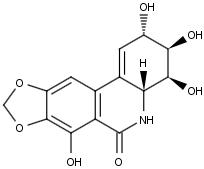
New research in the FASEB Journal suggests that narciclasine, a natural compound found in daffodil bulbs, markedly reduces cancer cell proliferation and migration. When looking for new ways to treat aggressive brain cancers, an international team of scientists turned a new leaf and "discovered" the lowly daffodil. A new research study published in the November 2010 print issue of The FASEB Journal [see below] offers hope that a natural compound found in daffodil bulbs, called narciclasine, may be a powerful therapeutic against biologically aggressive forms of human brain cancers.
"We are planning to move a narciclasine derivative toward clinical trials in oncology within a three to four year period in order to help patients with brain cancers, including gliomas, as well as brain metastases," said Robert Kiss, Ph.D., co-author of the study from the Laboratory of Toxicology at the Institute of Pharmacy at the Universite Libre de Bruxelles in Brussels, Belgium. "We hope narciclasine could be given to brain cancer patients in addition to conventional therapies."
To make this discovery, Kiss and colleagues used computer-assisted techniques to identify targets for narciclasine in cancer cells. The strongest potential candidate to emerge was the eEF1A elongation factor. Researchers then grafted human melanoma brain metastatic cells into the brains of genetically altered mice. Results showed that the injected mice survived significantly longer when treated with narciclasine than those mice left untreated. The researchers believe that narciclasine selectively inhibits the proliferation of very aggressive cancer cells, while avoiding adverse effects on normal cells. Narciclasine could be used in the near future to combat brain cancers, including gliomas, and metastases such as melanoma brain metastases.
"Scientists have been digging in odd corners to find effective treatments for brain cancer for decades, and now they've found one in daffodils." said Gerald Weissmann, M.D., Editor-in-Chief of The FASEB Journal, "It doesn't mean that you should eat daisies or daffodils for what ails you, but that modern medicinal chemistry can pluck new chemicals from stuff that grows in the garden. This is a good one!"
FASEB comprises 23 societies with more than 100,000 members, making it the largest coalition of biomedical research associations in the United States. FASEB enhances the ability of scientists and engineers to improve - through their research - the health, well-being and productivity of all people. FASEB's mission is to advance health and welfare by promoting progress and education in biological and biomedical sciences through service to our member societies and collaborative advocacy.
Further Information:
Gwendoline Van Goietsenoven et al.:
Targeting of eEF1A with Amaryllidaceae isocarbostyrils as a strategy to combat melanomas.
In: The FASEB Journal; vol. 24 no. 11 4575-4584; published online before print July 19, 2010, DOI 10.1096/fj.10-162263
Quelle: Federation of American Societies for Experimental Biology, FASEB
Last update: 03.11.2010
Perma link: https://www.internetchemistry.com/news/2010/nov10/narciclasine-against-brain-cancer.php
More chemistry: index | chemicals | lab equipment | job vacancies | sitemap
Internetchemistry: home | about | contact | imprint | privacy
© 1996 - 2023 Internetchemistry
